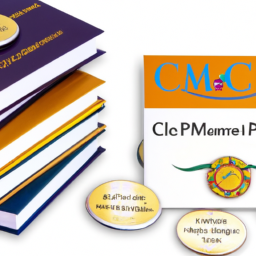Do you want to ace the CMI exam? Well, you’re in luck!
In this article, we’ll dive into the 10 critical concepts that are tested in the exam.
From key principles of marketing to ethical and legal considerations, we’ll cover it all.
So, if you’re ready to boost your knowledge and enhance your chances of success, let’s get started!
Key Takeaways
- The CMI Exam is a comprehensive assessment of marketing knowledge and skills, covering topics such as market research, consumer behavior, advertising, branding, and digital marketing.
- Passing the exam earns the prestigious CMI certification, enhancing career prospects and earning potential.
- Target audience identification, brand positioning strategies, and tailored marketing messages are crucial for effective marketing.
- Strategic planning frameworks, competitive advantage analysis, and effective implementation are key to successful marketing strategies.
Overview of the CMI Exam
You’ll need to understand the overview of the CMI Exam before diving into the critical concepts tested.
The CMI Exam is a comprehensive assessment that evaluates your knowledge and skills in marketing. It covers a wide range of topics, including market research, consumer behavior, advertising, branding, and digital marketing.
By successfully passing the exam, you can earn the prestigious CMI certification, which demonstrates your expertise and credibility in the field of marketing. Obtaining the CMI certification has numerous benefits.
It enhances your career prospects, increases your earning potential, and provides you with a competitive edge in the job market. Additionally, it allows you to stay updated with the latest marketing trends and best practices.
Now, let’s explore the key principles of marketing.
Key Principles of Marketing
In this discussion, you will explore two key principles of marketing: target audience identification and brand positioning strategies.
Understanding your target audience is crucial for effectively reaching and engaging potential customers. By identifying your target audience, you can tailor your marketing messages and strategies to resonate with their specific needs, preferences, and behaviors. This allows you to create more targeted and impactful marketing campaigns that are more likely to generate positive results.
On the other hand, brand positioning strategies help differentiate your brand from competitors and establish a unique value proposition. This involves determining how you want your brand to be perceived in the minds of consumers and positioning it in a way that sets it apart from others in the market. By highlighting your brand’s unique qualities, benefits, and values, you can attract and retain customers who resonate with your brand and what it stands for.
Target Audience Identification
Identifying the target audience is crucial for effective marketing strategies. To reach the right customers, you need to understand their needs, preferences, and behaviors. This involves target audience segmentation and consumer behavior analysis. By dividing your audience into distinct groups based on demographics, psychographics, and behaviors, you can tailor your marketing messages and tactics to resonate with each segment. Conducting thorough consumer behavior analysis helps you gain insights into why and how your target audience makes purchasing decisions. This information allows you to create targeted marketing campaigns that are more likely to capture their attention and persuade them to take action. To illustrate the importance of target audience identification, consider the following table:
| Target Audience Segment | Characteristics |
|---|---|
| Millennials | Tech-savvy, value experiences, socially conscious |
| Baby Boomers | Traditional, brand loyal, value quality |
| Gen Z | Digital natives, seek authenticity, crave personalization |
| Working professionals | Time-constrained, seek convenience, value efficiency |
Understanding these segments and their unique characteristics can help you tailor your marketing strategies to effectively engage and persuade your target audience.
Brand Positioning Strategies
To effectively position your brand in the market, it’s important to understand the unique value and benefits it offers to your target audience.
This can be achieved through a brand positioning analysis, which involves evaluating your brand’s strengths, weaknesses, opportunities, and threats in relation to your competitors.
By conducting this analysis, you can identify your competitive advantage strategies, which will differentiate your brand from others in the market.
These strategies can include highlighting your brand’s unique features, emphasizing the benefits it provides to customers, and showcasing how it solves their problems or meets their needs better than competitors.
Strategic Planning and Implementation
Strategic planning and implementation are crucial for the success of any organization. By utilizing strategic planning frameworks and conducting a competitive advantage analysis, you can effectively chart the course for your organization’s future.
These frameworks provide a structured approach to aligning your organization’s goals, resources, and actions. They help you identify and capitalize on your strengths, while also addressing any weaknesses or threats.
Through a competitive advantage analysis, you can identify the unique qualities that set your organization apart from the competition. This analysis allows you to leverage these strengths to gain a competitive edge in the market.
Once you have a clear strategic plan in place, it is essential to implement it effectively. This involves translating the strategy into actionable steps, assigning responsibilities, setting targets, and monitoring progress.
Consumer Behavior and Market Research
Now that you have a good understanding of strategic planning and implementation, let’s dive into the world of consumer behavior and market research.
In this section, you will learn about the factors that influence consumer decision-making and the importance of market segmentation.
Consumer decision-making is a complex process that involves various psychological, social, and cultural factors. By understanding these factors, marketers can better tailor their products and marketing strategies to meet the needs and desires of their target customers.
Market segmentation, on the other hand, involves dividing a market into distinct groups of consumers who have similar needs, wants, and preferences. This allows marketers to create more targeted and effective marketing campaigns that resonate with specific consumer segments.
Understanding consumer behavior and conducting market research are crucial for companies to stay ahead of the competition and drive business growth. With this knowledge, companies can develop innovative products and services that meet the evolving needs of consumers.
With that in mind, let’s move on to the next section, where we will explore the exciting world of product development and innovation.
Product Development and Innovation
In this section, you will explore the key points of the design thinking process and market research techniques.
Design thinking is a problem-solving approach that focuses on understanding the needs and preferences of the target audience.
Market research techniques, on the other hand, involve gathering and analyzing data to gain insights into consumer behavior and market trends.
Together, these two concepts can help you develop innovative products that meet the demands of your target market.
Design Thinking Process
The Design Thinking Process is a creative problem-solving approach that emphasizes empathy and iteration. It is a method used to tackle complex problems and develop innovative solutions.
By putting yourself in the shoes of the end user and understanding their needs, you can gain valuable insights that will inform the design process. The Design Thinking Process consists of several stages, including empathize, define, ideate, prototype, and test. Each stage encourages a different perspective and allows for a deep exploration of potential solutions.
This process fosters a culture of innovation and encourages thinking outside the box. It not only helps in developing innovative products and services but also in creating meaningful experiences for the users.
Incorporating the Design Thinking Process in your innovation strategies can lead to breakthrough ideas and successful outcomes.
Market Research Techniques
Market research techniques can provide valuable insights into consumer preferences and help businesses make informed decisions. There are two main types of market research: quantitative and qualitative research. Quantitative research focuses on collecting numerical data and analyzing it statistically to identify patterns and trends. This type of research is often conducted through surveys, questionnaires, and data analysis. On the other hand, qualitative research involves gathering non-numerical data through methods like interviews, focus groups, and observations. This type of research provides a deeper understanding of consumer behavior and motivations. Additionally, market research can be categorized as primary or secondary research. Primary research involves gathering information directly from the target market, while secondary research involves analyzing existing data and research conducted by others. Both primary and secondary research are essential for a comprehensive market analysis.
| Quantitative Research | Qualitative Research |
|---|---|
| Numerical data | Non-numerical data |
| Surveys, questionnaires, data analysis | Interviews, focus groups, observations |
| Identifying patterns and trends | Understanding consumer behavior and motivations |
| Primary and secondary research | Primary and secondary research |
Branding and Advertising Strategies
Developing an effective branding and advertising strategy requires understanding your target audience and creating compelling messages that resonate with them.
To achieve success in this area, consider the following strategies and techniques:
-
Identify your target audience: Conduct thorough market research to understand who your ideal customers are, their demographics, needs, and preferences.
-
Define your brand identity: Clearly articulate what your brand stands for, its values, personality, and unique selling proposition.
-
Create a consistent brand message: Ensure that your brand message is consistent across all channels and touchpoints, including your website, social media, and advertising campaigns.
-
Utilize storytelling techniques: Craft compelling narratives that engage and evoke emotions in your audience, helping them connect with your brand.
-
Choose the right advertising channels: Select the most appropriate advertising channels that reach your target audience effectively, whether it be digital platforms, print media, or television.
Pricing and Sales Promotion Techniques
In this section, we will discuss three key points related to pricing and sales promotion techniques: dynamic pricing strategies, bundling and cross-selling, and discounting and couponing.
These strategies are crucial for businesses to effectively price their products and services, attract customers, and increase sales.
Dynamic Pricing Strategies
To understand dynamic pricing strategies, it’s important to consider how they can benefit your business. By implementing these strategies, you can optimize your prices and maximize your profits.
Here are five key benefits of dynamic pricing:
-
Increased revenue: By adjusting prices based on demand, you can capture more value from customers willing to pay higher prices.
-
Improved competitiveness: Dynamic pricing allows you to respond quickly to market changes and stay ahead of competitors.
-
Better inventory management: By aligning prices with demand forecasts, you can reduce excess inventory and minimize costs.
-
Personalized pricing: Dynamic pricing enables you to offer personalized discounts or promotions to specific customer segments, improving customer satisfaction.
-
Real-time insights: These strategies provide valuable data on customer behavior and pricing elasticity, allowing you to make informed decisions.
Implementing dynamic pricing strategies can give your business a competitive edge and drive growth by maximizing revenue and optimizing pricing based on demand forecasting.
Bundling and Cross-Selling
Bundling and cross-selling can be effective strategies for increasing sales and maximizing customer value.
Bundling strategies involve combining multiple products or services together and offering them as a package deal. This not only encourages customers to purchase more items at once but also provides them with added convenience and value.
Cross-selling tactics, on the other hand, involve recommending complementary products or services to customers based on their purchase history or preferences. This helps to increase the average order value and encourage repeat purchases.
By implementing these strategies, businesses can not only boost their sales but also enhance the overall customer experience.
Now, let’s explore another important concept in increasing sales and maximizing customer value: discounting and couponing.
Discounting and Couponing
Discounting and couponing can be effective strategies for attracting customers and increasing sales. By offering discounts and coupons, you can incentivize potential customers to make a purchase and encourage repeat business.
Here are five key points to consider when implementing discounting and couponing strategies:
-
Targeted promotions: Tailor your discounts and coupons to specific customer segments or demographics to maximize their effectiveness.
-
Clear terms and conditions: Ensure that the terms and conditions of your discounts and coupons are transparent and easy to understand to avoid any confusion or frustration.
-
Limited-time offers: Create a sense of urgency by offering time-limited discounts and coupons, compelling customers to take immediate action.
-
Promote customer loyalty: Use discounts and coupons as a way to reward and retain your loyal customers, encouraging them to continue supporting your business.
-
Measure and analyze results: Regularly track and analyze the impact of your discounting and couponing strategies to identify what works best and make necessary adjustments.
Distribution Channels and Supply Chain Management
Managing distribution channels and supply chain is crucial for your business success. A well-defined distribution strategy ensures that your products reach the right customers at the right time. By optimizing your supply chain, you can minimize costs, improve efficiency, and enhance customer satisfaction.
To develop an effective distribution strategy, you need to identify the most appropriate channels for your target market and create partnerships with reliable distributors. Additionally, supply chain optimization involves streamlining processes, reducing lead times, and managing inventory effectively. By doing so, you can respond quickly to customer demands and avoid stockouts or excess inventory.
Ensuring smooth coordination between distribution channels and supply chain management is essential to meet customer expectations and stay ahead of the competition. With a solid foundation in distribution and supply chain management, you can now explore the benefits of digital marketing and social media in the next section.
Digital Marketing and Social Media
To effectively leverage digital marketing and social media, you should focus on building a strong online presence and engaging with your target audience. Here are some key strategies to consider:
-
Develop a comprehensive content strategy that aligns with your brand’s goals and resonates with your audience. This includes creating valuable and relevant content across different platforms such as blogs, videos, and social media posts.
-
Incorporate influencer marketing into your digital marketing efforts. Engaging with influencers who have a large following and influence in your industry can help expand your reach and credibility.
-
Optimize your website and social media profiles for search engines to improve your online visibility. This includes using relevant keywords, creating quality backlinks, and regularly updating your content.
-
Utilize social media advertising to target specific demographics and increase your brand awareness. Platforms like Facebook and Instagram offer powerful targeting options to reach your ideal customers.
-
Monitor and analyze your online presence using analytics tools to measure the success of your digital marketing efforts and make data-driven decisions.
By implementing these strategies, you can effectively leverage digital marketing and social media to boost your brand’s visibility, engage with your target audience, and drive business growth.
Now, let’s explore the ethical and legal considerations in marketing.
Ethical and Legal Considerations in Marketing
When implementing digital marketing and social media strategies, it’s important to consider the ethical and legal implications to ensure compliance and maintain a positive brand image.
Ethical implications refer to the moral considerations and standards that guide marketing practices. It is crucial to conduct marketing activities in an honest, transparent, and responsible manner to protect the interests of consumers and society as a whole.
Legal regulations, on the other hand, pertain to the laws and regulations that govern marketing activities. These regulations vary from country to country and may include rules on consumer protection, privacy, intellectual property, and advertising standards.
Adhering to ethical principles and legal regulations is not only a legal requirement but also a way to build trust with consumers and safeguard the reputation of your brand.
Frequently Asked Questions
What Are the Eligibility Criteria to Take the CMI Exam?
To take the CMI exam, you need to meet certain eligibility criteria. These include having at least three years of professional experience in a management role and a bachelor’s degree or equivalent.
The exam lasts for three hours and consists of 150 multiple-choice questions. It covers various critical concepts related to management.
How Long Is the CMI Exam and How Many Questions Are Included?
The CMI exam duration and number of questions vary depending on the level you’re taking.
For the Level 1 exam, you’ll have 2 hours to complete 100 multiple-choice questions.
Level 2 gives you 2.5 hours for 100 multiple-choice questions and 2 case study questions.
Level 3 requires 3 hours to answer 100 multiple-choice questions and 3 case study questions.
Make sure to manage your time effectively and prepare accordingly.
Are There Any Prerequisites or Recommended Study Materials for the CMI Exam?
To prepare for the CMI exam, it’s important to have the right study materials. While there are no strict prerequisites, it is highly recommended to review relevant industry literature and resources.
These materials will help you gain a deeper understanding of the critical concepts tested in the exam. By immersing yourself in the subject matter, you’ll be better equipped to tackle the questions and succeed in the CMI exam.
Can the CMI Exam Be Taken Online or Is It Only Available at Physical Testing Centers?
The CMI exam can be taken both online and at physical testing centers. This flexibility allows you to choose the option that suits you best. If you prefer the convenience of taking the exam from the comfort of your own home or office, online testing is available.
However, if you prefer a more traditional testing environment, physical testing centers are also an option. This ensures that you have the flexibility to choose the testing method that works best for you.
How Often Is the CMI Exam Updated to Reflect the Latest Marketing Trends and Practices?
The CMI exam is regularly updated to ensure it reflects the latest marketing trends and practices. This is important because it ensures that the exam remains relevant to the industry.
For example, the exam may incorporate case studies or hypothetical scenarios that reflect real-world marketing situations. By doing so, it challenges candidates to apply their knowledge to current marketing challenges.
This frequent update frequency ensures that the exam remains a valuable assessment tool for professionals in the field.
Conclusion
Congratulations! You’ve reached the end of your journey through the 10 critical concepts tested in the CMI exam.
Just like a skilled sailor navigating treacherous waters, you’ve learned to navigate the principles of marketing, strategic planning, consumer behavior, and more.
With your newfound knowledge, you’re equipped to conquer the challenges of product development, pricing, distribution, digital marketing, and ethical considerations in the vast sea of marketing.
So set sail, my friend, and may your marketing endeavors be smooth sailing!





















